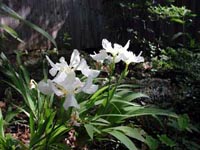Resource Library
Plant of the Week: Roof Iris, Japanese
The University of Arkansas System Division of Agriculture does not promote, support or recommend plants featured in "Plant of the Week." Please consult your local Extension office for plants suitable for your region.
Plant of the Week
Japanese Roof Iris
Latin: Iris tectorum

Plants come and go in popularity. At the moment, irises are on the slide, being eclipsed by a host of perennials with a longer period of bloom. But, irises are a diverse group of plants, and they have more to offer than just the gaudy flowers of the flags most associate with the group. One of my favorite species is Japanese roof iris (Iris tectorum).
The roof iris is native to China, but was first discovered in the 1860s, growing in Japan on the roofs, hence the common name. It grows about a foot tall with a spreading, rhizomatous habit common to most irises. Leaves are light green, about a foot long, broadly sword shaped and slightly corrugated down their length.
Instead of standing stiffly erect, the leaves arch over, making them useful as a graceful groundcover. While not completely evergreen, the roof iris keeps its leaves through most of the winter in my garden. A variegated foliage form is available, but it has not persisted for me.
The flowers appear in late April and early May atop a 2-foot long scape that has a couple branches, each of which produces one or two blooms. The 4-inch wide flowers are usually a muted lavender but a white form is also common. Like most iris, the floral display is short, lasting about two weeks.
This charming little plant became known as the Japanese roof iris because that is where it was first observed by a Russian scientist, Carl Maximowicz (1827-1891). He spent three and a half years botanizing in Japan in the early 1860s and introduced numerous Japanese plants to Europe through his base in St. Petersburg.
In China, apparently the original home of the roof iris where it has been grown since at least seventh century, the plant grows on the ground like any sensible iris. But in Japan, it was found growing on the ridges of their thatched roofs.
Apparently this tradition started in Japan because of a decree by a Japanese emperor during a period of wartime when it became illegal to waste land growing flowers. All available land had to be used for rice or vegetables.
The main reason for growing the plant was not for its flowers, but for a white powder that was made by grinding the roots. The makeup used to create the white faces of the Geisha girls was made from the rhizomes. So, the plants moved from the garden to the roofs where it remained until being "discovered" by science.
I use this plant in my Japanese garden where the linear form of the leaves is echoed amongst three different plants. The largest of these is a broad-leafed bamboo that grows about 3 feet tall. Around it is a large groundcover planting of dwarf mondo grass. In the midst of this is a clump of roof iris. The leaves of each have a similar shape, but the contrast in size creates a pleasing effect.
The Japanese roof iris is unique amongst irises because it grows about as well in the shade as in the sun. Like all irises, it should be planted with the rhizomes just at the surface of the soil. The colony will slowly increase in size or you can speed the process along by dividing the plants in the fall. If happy, it will reseed. It seems immune to pests.
By: Gerald Klingaman, retired
Extension Horticulturist - Ornamentals
Extension News - February 4, 2005
The University of Arkansas System Division of Agriculture does not maintain lists of retail outlets where these plants can be purchased. Please check your local nursery or other retail outlets to ask about the availability of these plants for your growing area.